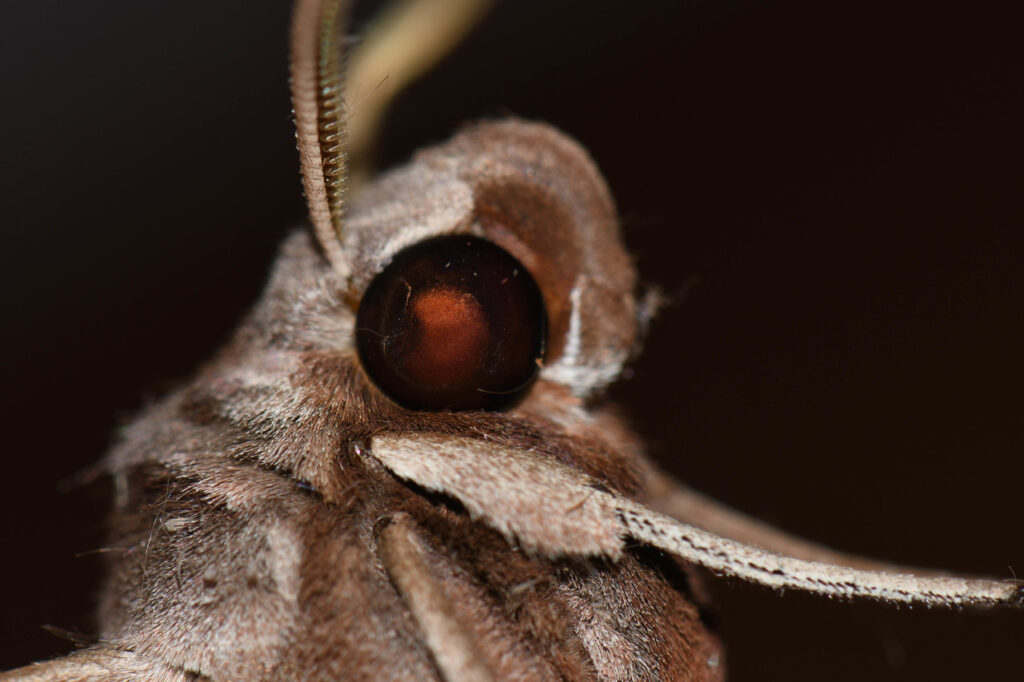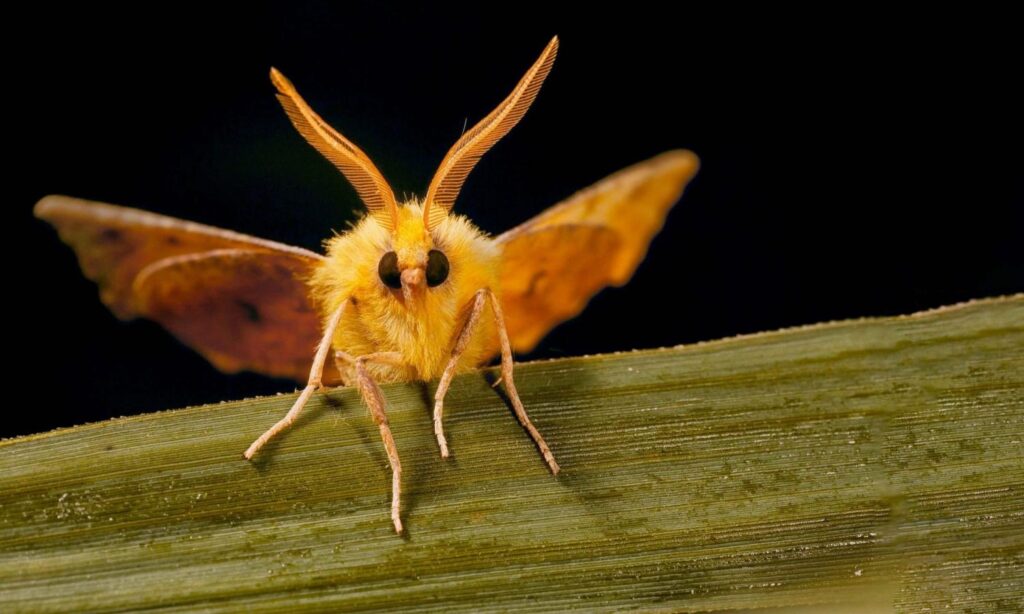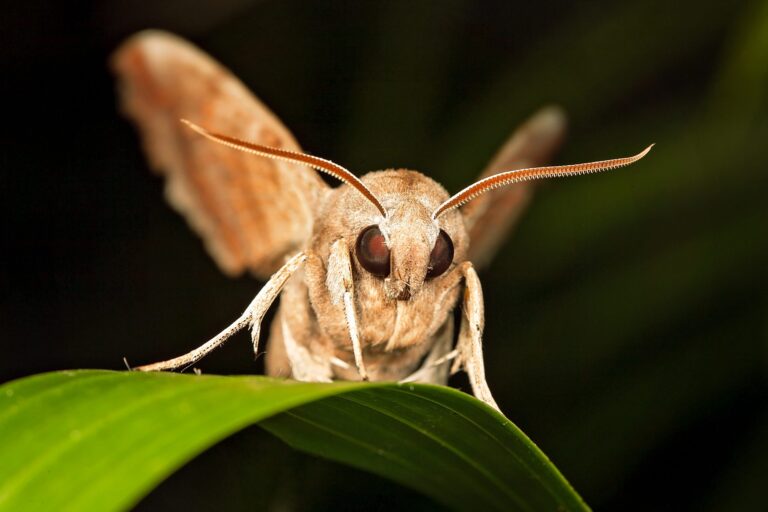Moths have specialized adaptations for low-light conditions but cannot see in complete darkness. They possess compound eyes sensitive to ultraviolet and blue light, allowing them to navigate at dawn and dusk.
Moths are highly sensitive to changes in light intensity, which helps them find light sources but still require some ambient light for effective vision. They lack true night vision seen in animals like owls.
How do moths’ compound eyes work?
In the realm of nocturnal insects, moths’ compound eyes reveal a fascinating world of adaptation and survival.
Structure of Moth Eyes
Compound Eyes: Moths, like many other insects, have compound eyes, which consist of numerous tiny units called ommatidia.
Each ommatidium is like a miniature eye itself, containing its lens and photoreceptor cells.
Compound eyes provide a wide field of view, which is advantageous for detecting predators and finding mates.
Ommatidia: Ommatidia are the fundamental building blocks of a moth’s compound eye. These units work in parallel to capture and process visual information. Each ommatidium focuses on a small portion of the overall visual field. The combined input from all ommatidia creates a mosaic-like image.
Sensitivity to Different Wavelengths of Light

Ultraviolet and Blue Light: Moths are particularly sensitive to shorter wavelengths of light, such as ultraviolet (UV) and blue light.
This sensitivity is due to the presence of specialized photoreceptor cells that can detect these wavelengths.
Moths rely on their sensitivity to UV and blue light for various purposes, including navigation and finding nectar-rich flowers.
These wavelengths are more prevalent during dawn and dusk, aligning with their crepuscular or nocturnal activity.
Sensitivity to Changes in Light Intensity
Adaptation for Detecting Faint Light Sources: Moths have a remarkable ability to detect even the faintest sources of light. This sensitivity is crucial for them to locate potential mates or food sources.
Moths are highly responsive to rapid changes in light intensity, which helps them spot subtle variations in their environment. It enables them to find dimly lit areas where they might rest or hide during the day.
Comparison with Human Vision: Moth vision differs significantly from human vision in several ways:
- Moths see a mosaic of images through their compound eyes, while humans see a single, coherent image through their single-lens eyes.
- Humans are more sensitive to longer wavelengths of light, such as red and green, which are more abundant during the day.
- Unlike humans, moths can perceive ultraviolet light, which is invisible to us.
- Moths excel in low-light conditions, making them well-suited for their crepuscular and nocturnal lifestyles, while humans rely on artificial lighting or specialized equipment to see in the dark.
How do moths navigate during dusk and dawn?
Moths are primarily crepuscular and nocturnal insects, which means they are most active during the periods of dawn and dusk, as well as at night. Crepuscular activity allows moths to take advantage of the transitional light conditions when natural predators may be less active.
During dusk and dawn, moths engage in various behaviors such as foraging for food, finding mates for reproduction, and seeking shelter.
Attraction to Artificial Lights:
Moths are well-known for their attraction to artificial lights, such as street lamps, porch lights, and headlights.
The reason behind this attraction is not entirely understood, but several theories have been proposed:
Phototaxis: Moths may exhibit positive phototaxis, meaning they are naturally drawn to light sources. They may mistake artificial lights for the moon or stars, which they use for navigation.
Disruption of Natural Navigation: Artificial lights can disrupt moths’ natural navigation systems. Instead of using distant celestial objects for orientation, they become disoriented by the close and intense artificial light sources.
Camouflage Hypothesis: Some researchers suggest that moths may be attracted to lights because they have evolved to seek out open spaces (like moonlit areas) as a way to avoid predators lurking in darker, vegetated areas. Artificial lights create a similar open-space illusion.
This attraction to artificial lights can be problematic for moths as they may become exhausted, disoriented, or fall prey to predators when they approach these sources.
Dependency on Ambient Light for Navigation:
Moths depend on ambient light, including moonlight and starlight, for navigation. They use these celestial cues to maintain a straight flight path and to orient themselves.
Moonlight, in particular, is a reliable source of orientation for moths. They can adjust their flight direction based on the position and brightness of the moon in the sky.
When moths encounter artificial lights, especially bright ones, they can become confused and lose their ability to navigate using natural celestial cues.
This dependency on ambient light also highlights the challenges moths face when exposed to light pollution from human activities, as it can disrupt their natural behavior and potentially lead to negative consequences for their survival and reproduction.
What are the limitations of moths’ night vision?

Moths, despite their remarkable adaptations for low-light vision, still have limitations when it comes to seeing in complete darkness.
Their compound eyes and photoreceptor cells require at least some ambient or background light to function effectively.
In absolute darkness, such as in caves or underground environments with no external light sources, moths would likely struggle to perceive their surroundings or navigate.
Contrast with Animals Possessing True Night Vision:
Moths’ vision in low-light conditions differs significantly from animals possessing true night vision, like some nocturnal mammals and birds, such as owls.
Animals with true night vision have specialized adaptations that allow them to see in near-total darkness, often relying on highly sensitive rod cells in their retinas.
Nocturnal mammals like owls, for instance, have large eyes with a high density of rods, which are extremely sensitive to even tiny amounts of light.
These animals can see in conditions where there is almost no ambient light, making them highly efficient nocturnal predators.
In contrast, moths rely on available ambient light, particularly moonlight and starlight, as well as their sensitivity to shorter wavelengths like UV and blue light, to navigate and find resources.
Moths’ vision is adapted to crepuscular and low-light conditions rather than true night vision, and they are not capable of seeing in complete darkness without any source of illumination.
FAQ’s
Do moths like the dark?
Yes, moths are primarily nocturnal insects, so they are naturally adapted to low-light and dark conditions.
Can moths see in the light?
Yes, moths can see in various light conditions, but they are more adapted to low-light and dim environments.
Do moths stay in the dark?
Moths are more active at night, but they may seek shelter in dark places during the day to avoid predators and conserve energy.
What happens to moths at night?
Moths become active at night, engaging in activities like foraging for food, finding mates, and navigating using moonlight and stars.
Is it OK to sleep with moths?
It’s generally best to keep moths out of sleeping areas, as their presence can be disruptive. Moths are attracted to light sources and may flutter around, potentially causing disturbances.
Why am I afraid of moths?
Fear of moths, known as “mottephobia” or “lepidopterophobia,” can be attributed to individual experiences or a general aversion to insects. It varies from person to person.
Final Words
In conclusion, moths possess a unique and highly specialized vision system adapted for low-light conditions, but they face limitations in complete darkness. Their compound eyes, composed of ommatidia, are sensitive to shorter wavelengths like ultraviolet and blue light, making them well-suited for crepuscular and nocturnal activity.
Moths also exhibit a remarkable ability to detect even faint changes in light intensity, enabling them to navigate and locate essential resources. However, their vision differs significantly from human sight, and they lack true night vision, which is a distinct adaptation seen in some nocturnal animals like owls.
Additionally, moths rely on ambient light, including moonlight and starlight, for navigation, making them vulnerable to disorientation in the presence of artificial lights. These unique aspects of moth vision underscore their fascinating adaptations and the challenges they face in an increasingly illuminated world.

